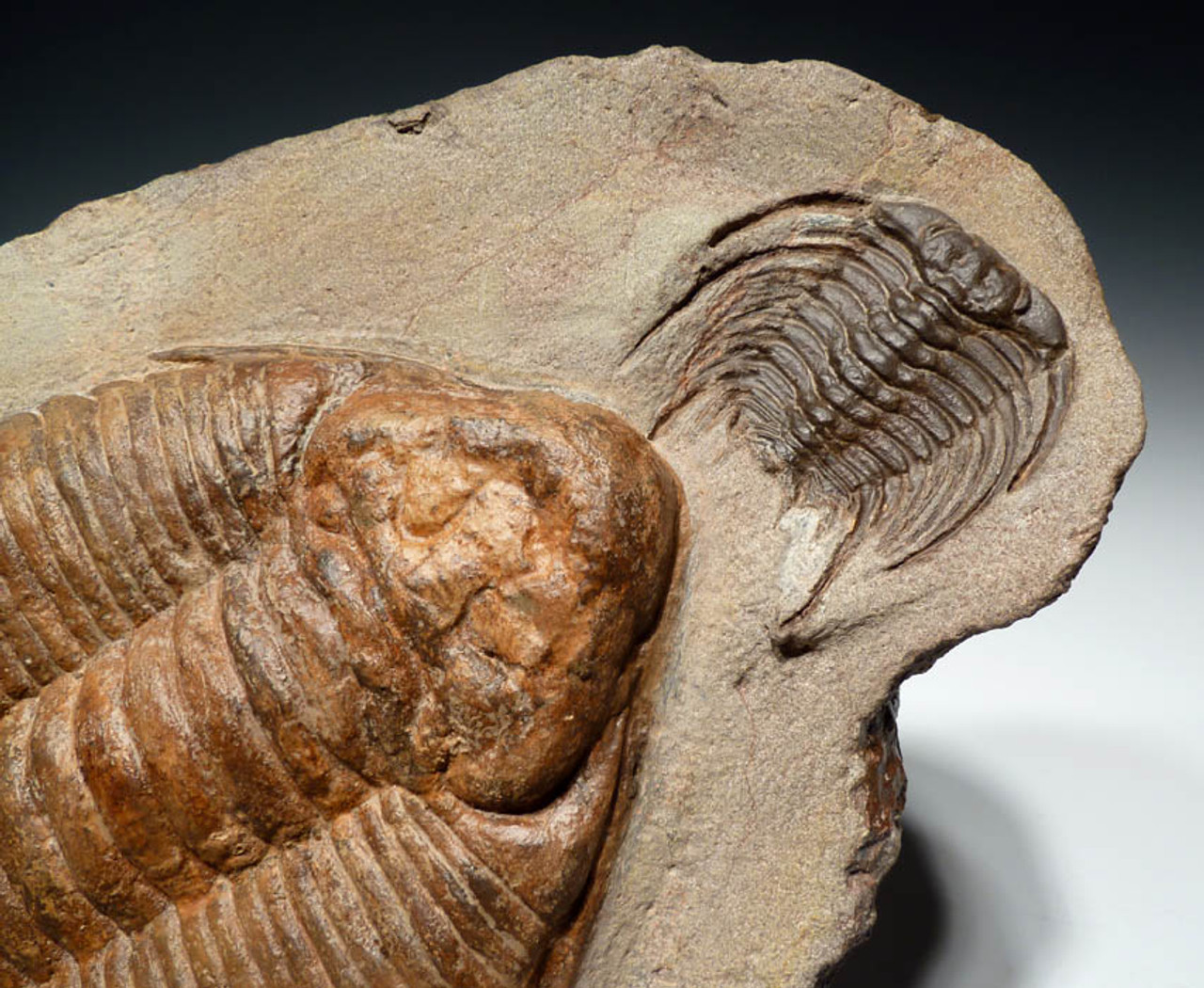Product Description
ITEM #
|
TRX053
|
||
ID
|
Uralichas with Selenopeltis and Onnia
|
||
FOUND
|
Elkaid Errami - Anti-Atlas Mountains, Morocco
|
||
AGE
|
UPPER ORDOVICIAN: 460 - 445 million years ago
|
||
SIZE
|
20" x 11.75" overall, Uralichas 15" long
|
||
CONDITION
|
TYPICAL REPAIR, 5% RESTORATION TO PYGIDIUM
|
||
NOTE
|
RAREST LARGE TRILOBITE!!! FOUND TOGETHER IN THIS POSITION.
|
||
INCLUDES STAND - Actual Item - One Only
Comes with a certificate of authenticity / information sheet |
|||
CLICK HERE TO LEARN MORE ABOUT TRILOBITES
This trilobite is so rare that after selling a prior specimen several years ago, one of only 3 complete examples known at the time, we intended to remove the section of Uralichas from our website thinking we would never have another. The only reason we kept it is to reference the sold example and allow site visitors to find it should they be browsing the pages.
Now we have the incredible good fortune of securing another of these exceedingly rare examples. Since that first specimen, several years ago, we have known of ONLY five or six authentic examples of this kind from Morocco at the time of this posting. Of those five or six, not all were complete and some had restoration (not necessarily disclosed but obvious) but despite the restoration, mostly complete specimens of the elusive monster of the Ordovician remain incredibly rare. With only a literal handful of these examples discovered and known, it goes without saying this is truly a rare life-time opportunity to acquire one.
Not only is this a practically impossible-to-find "holy grail" fossil amongst experienced trilobite collectors, it is a magnificent specimen, aesthetically-speaking, as well. This Uralichas is present with other naturally associated trilobites on the same rock plate. The large Uralichas sp. trilobite appears to be chasing a Selenopeltis longispinus trilobite and leaving in its wake, several Onnia trilobites off to its posterior right side. The Selenopeltis and Onnia trilobites are 100% original and authentic. The Uralichas plate broke in the process of its discovery and the pygidial spines became destroyed necessitating its reconstruction. Some tips of the posterior pleural thoracic spines are also restored as they too, became damaged in the splitting of the rock which is the only way these can be found. The remainder of the pygidium body and posterior thorax are present and original with expected repair, as is the majority of the entire thorax and cephalon. The trilobite retains incredible natural colors and textures and is not distorted, possessing full, life-like inflation off the rock. ALL of these species are natural to the formation and naturally found together which makes this piece all the more impressive in light of its immeasurable rarity to begin with!
In many fields of rare collectibles, prices run into the hundreds of thousands or millions of dollars to own an original and authentic example of anything that there is only 50 or even 10 known to exist. Here is a specimen that is only one of maybe 6 known and this one is one of the most aesthetic with other associated trilobites on the same rock! A customer once relayed to us that you can't go to an art auction at Christies or Sotheby's and find a simple original sketch or drawing from relatively unknown artists that starts bidding for under $50,000. Recent major auctions running all through the depressed world economies continue to set new, unbelievably high realized prices on all forms of rare collectibles. Why? Because many know that over time, intangible investments like stocks, bonds, currencies, commodities, etc.. have their values driven mostly by emotion and because of this, can make fortunes disappear overnight. Investing in an INTRINSICALLY RARE object is common sense when their is a market for the object and still today, fossils such as these remain grossly UNDER-valued. Put into perspective, the price for this unbelievably rare specimen is an enormous bargain. What would most rare collectibles sell for if they were only one of a handful known in the world? Certainly for many, many times the modest price of this fossil. The fact that this huge trilobite is not only RARE but truly an impressive display specimen provides all the right ingredients to classify this as a highly promising investment you can enjoy with pride every time you look at it. Certainly, every major public museum lacks such a specimen in their collections.
 US DOLLAR
US DOLLAR
 EURO
EURO
 AUSTRALIAN DOLLAR
AUSTRALIAN DOLLAR
 CANADIAN DOLLAR
CANADIAN DOLLAR
 POUND STERLING
POUND STERLING
























